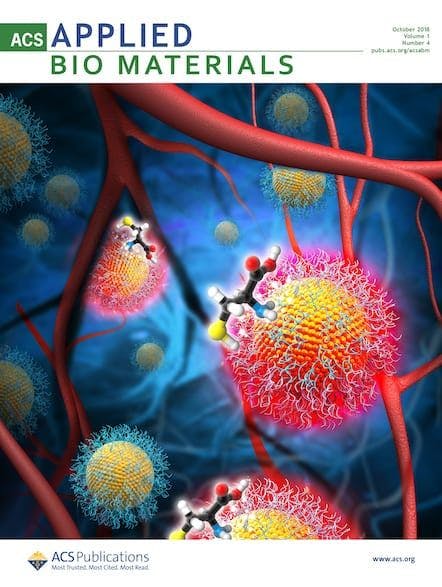The American Chemical Society and ACS Publications are excited to share their portfolio of physical chemistry journals at the APS March Meeting 2019 in Boston March 4-8. We will be in the Exhibit Hall at Booth 710 and hope you will stop by to see us. Meet ACS Publications Editorial Staff and Get a JPC […]


The American Chemical Society and ACS Publications are excited to share their portfolio of physical chemistry journals at the APS March Meeting 2019 in Boston March 4-8. We will be in the Exhibit Hall at Booth 710 and hope you will stop by to see us.
Meet ACS Publications Editorial Staff and Get a JPC B T-Shirt
ACS Publications Development Editor Dr. William (Bill) Aumiller will be on hand twice during the week to answer your questions about publishing with ACS journals. Come meet him and enjoy some snacks and coffee while you learn more about publishing with Physical Chemistry Journals from the American Chemical Society.
Join Dr. Aumiller at Booth 710:
- Tuesday, March 5, 10:30 a.m. to 11:30 a.m.
- Thursday, March 7, 10:30 a.m. to 11:30 a.m.
We’ll also be giving away “B is for Biophysics” t-shirts from The Journal of Physical Chemistry B while supplies last!
The leading journals in physical chemistry with the most articles published annually and the largest worldwide readership. In 2018, these four journals together had:
- 6,219 published articles
- 354,802 citations
- The Journal of Physical Chemistry A: publishes research on isolated molecules, clusters, radicals, and ions; environmental chemistry, geochemistry, and astrochemistry; new tools and methods. The JPC A scope includes kinetics, dynamics, photochemistry, excited states, spectroscopy, molecular structure, quantum chemistry, environmental chemistry, combustion chemistry, atmospheric chemistry, aerosol processes, geochemistry, and astrochemistry.
- The Journal of Physical Chemistry B is a great place to publish research on biophysics, biomaterials, liquids, or soft matter. JPC B’s scope includes biophysics; physical chemistry of biological systems, biomolecules, biomaterials, membranes, liquids, chemical and dynamical processes in solution, spectroscopy in solution, fluid interfaces, colloids, polymers, soft matter, surfactants, and glassy materials.
- The Journal of Physical Chemistry C publishes research on energy conversion and storage; catalysis; optical, electronic, and magnetic properties and processes; interfaces; nanomaterials and hybrid materials. JPC C’s scope includes energy conversion and storage; energy and charge transport; surfaces; interfaces; porous materials; catalysis; plasmonics; optical, magnetic, and hybrid materials; and physical processes in nanomaterials and nanostructures.
- The Journal of Physical Chemistry Letters is devoted to reporting new and original experimental and theoretical basic research of interest to physical chemists, biophysical chemists, chemical physicists, physicists, material scientists, and engineers. The JPC Letters scope includes clusters, radicals, and ions; environmental chemistry spectroscopy and photochemistry; general theory; biophysical chemistry; biomolecules; biomaterials, surfactants and membranes; chemical and dynamical processes in solution; polymers, glasses, and soft matter; energy conversion and storage; plasmonics and optoelectronics; surfaces, interfaces, and catalysis; physical properties of nanomaterials and materials.
Open Access Journals from the American Chemical Society
All ACS Publications journals offer authors the option to publish their research open access. ACS also has two multidisciplinary, fully open access journals with scopes that include a broad range of physical chemistry topics:
- ACS Central Science, the Society’s award-winning, fully open access journal, is becoming the gold standard for trailblazing research publication. Led by Howard Hughes Medical Institute and Stanford University Professor Carolyn Bertozzi, and a team of award-winning researchers around the globe, the journal also publishes scientist commentary, forward-looking reviews, engaging interviews, and in-depth news articles.
- ACS Omega’s coverage spans the scope of all ACS journals. The journal focuses its editorial decisions on the research itself, not on the perceived evaluation of immediate impact. The ACS Omega article publishing charge (APC) is $750 and its authors get global exposure for their research, active researchers as editors, and rapid publishing times. Learn more about the benefits of publishing with ACS Omega.
Physics and chemistry, two households alike in dignity, may have an ancient grudge, but we don’t need to! Solar cells, graphene studies, molecular magnets, crystal structure determination: you’ll find it all in the Journal of the American Chemical Society (JACS). And while you’re reading the latest experimental study on topological insulators or thinking of applications for materials with photo-controlled magnetic orientation, consider that maybe it’s time to bury our strife. A perovskite by any other name, after all, would be just as efficient.
The American Chemical Society also publishes more than 20 additional journals that include physical chemistry topics in their scopes:
- ACS Applied Bio Materials (Deputy Editor Shu Wang) communicates the most recent and relevant breakthrough research dealing with the design and application of biological, biomedical, and bioinspired materials.
- ACS Applied Electronic Materials (Deputy Editor Hyun Jae Kim) publishes high-quality manuscripts on all aspects of electronic materials for emerging applications that have conducting, semiconducting, insulating, magnetic, optoelectronic, and thermoelectric properties.
- ACS Applied Energy Materials (Deputy Editor Gerald J. Meyer) maintains a sharp focus on energy applications, the range of chemistry involved is broad and the potential impact of the research is both enormous and urgent.
- ACS Applied Materials & Interfaces (Editor-in-Chief Kirk S. Schanze) is a truly international forum focusing on how newly-discovered materials and interfacial processes can be developed and used for specific applications.
- ACS Applied Nano Materials (Deputy Editor T. Randall Lee) provides rapid communication of state-of-the-art research. If you are working with material 500 nanometers and below, ACS Applied Nano Materials is interested! Applications need not be proven, but potential uses for the material should be clearly communicated in your abstract, introduction, and conclusion.
- ACS Applied Polymer Materials (Deputy Editor Jodie Lutkenhaus) publishes emergent polymers research in the applied materials community, including articles on the relationships among chemistry, structure, processing, morphology, properties, and function, as well as work that provides insights into mechanisms critical to the performance of an application.
- ACS Earth and Space Chemistry (Editor-in-Chief Joel D. Blum) includes the application of analytical, experimental and theoretical chemistry relevant to the earth and space. The journal publishes high- and low-temperature geochemistry, atmospheric chemistry, marine chemistry, planetary chemistry, astrochemistry, and analytical geochemistry.
- ACS Energy Letters (Editor-in-Chief Prashant V. Kamat) is the fastest communications journal in energy research, publishing breakthrough science edited by a team of prominent researchers. The journal’s average time from submission to publication for peer-reviewed Letters is just 35 days.
- ACS Macro Letters (Editor-in-Chief Stuart J. Rowan) publishes research in all areas of contemporary soft matter science in which macromolecules play a key role, including nanotechnology, self-assembly, supramolecular chemistry, biomaterials, energy generation and storage, and renewable/sustainable materials.
- ACS Nano (Editor-in-Chief Paul S. Weiss) publishes comprehensive articles on nanoscience and nanotechnology research at the interfaces of chemistry, biology, materials science, physics, and engineering. The journal facilitates communication among scientists developing new research opportunities and advancing the field through new discoveries.
- Biomacromolecules, (Editor-in-Chief Ann-Christine Albertsson) is the leading forum for the dissemination of cutting-edge research at the interface of polymer science and biology. Research published in the journal contains strong elements of innovation in terms of macromolecular design, synthesis, and characterization, or in the application of polymer materials to biology and medicine.
- Energy & Fuels (Editor-in-Chief Michael T. Klein) publishes energy research in the non-nuclear domain, directed at the formation of, exploration for, and production of fossil fuels and biomass; the properties and structure or molecular composition of both raw fuels and refined products; the chemistry involved in the processing and utilization of fuels; fuel cells and their applications; and analytical and instrumental techniques used in those areas.
- Industrial & Engineering Chemistry Research (Editor-in-Chief Phillip E. Savage) reports industrial and academic research in the broad fields of applied chemistry and chemical engineering with special focus on fundamentals, processes, and products.
- Journal of Chemical & Engineering Data (Editor-in-Chief Joan F. Brennecke) publishes data obtained from both experiment and computation, which are viewed as complementary. It is the only ACS journal primarily concerned with data on the phase behavior and the physical, thermodynamic, and transport properties of well-defined materials, including complex mixtures of known composition.
- Journal of Chemical Information & Modeling (Editor-in-Chief Kenneth M. Merz Jr.) publishes papers reporting new methodology and/or important applications in the fields of chemical informatics and molecular modeling. Specific topics include representation and computer-based searching of chemical databases, molecular modeling, computer-aided molecular design of new materials, catalysts, or ligands, and development of new computational methods or efficient algorithms for chemical software.
- Journal of Chemical Theory and Computation (Editors-in-Chief William L. Jorgensen and Gustavo E. Scuseria) publishes new theories, methodology, and important applications in quantum electronic structure, molecular dynamics, and statistical mechanics.
- Langmuir (Editor-in-Chief Françoise Winnik) is the leading journal on the fundamental science of systems and materials in which the interface dominates structure and function. Topics include adsorption, surfactants, emulsions, ultrathin films, measurements on interfaces and colloids, and electrochemistry, among others.
- Macromolecules (Editor-in-Chief Marc A. Hillmyer) publishes original research on all fundamental aspects of macromolecular science including synthesis, polymerization mechanisms and kinetics, chemical modification, solution/melt/solid-state characteristics, and surface properties of organic, inorganic, and naturally occurring polymers.
